
Copyright 2022 by Victoria Barr. The book author/artist retains sole copyright to their contributions to this book. No part of this book may be reproduced in any form or by any electronic or mechanical means without prior permission in writing.
Catalog edited by Eva Zak
Catalog designed by Karen M. Gutfreund, @karengutfreundart
2
Victoria Barr Paintings
By Victoria Barr
Edited by Eva Zak
3
4
5 Table of Contents Intro 4 Artist Statement 7 Early 9 Galaxies 17 Indonesia 27 Demons 39 Death 45 Amazon 57 Natural World 69 Palm 77 Conclusion 87 Exhibition History 89 Acknowledgements 90
Introduction
A large, quiet, well-lit room is filled with a small collection of art from various periods in history and of differing levels of renown. Joan Miro’s Man with a Pipe and an untitled Mark Rothko painting hang opposite Yves Tanguy’s The Lovers. Three small Baroque paintings are on display beside a print of Pablo Picasso’s Minotauromachy, while on the opposing wall, Henri Matisse’s La Palme is flanked by two Picasso Cubist drawings. A small pre-Columbian dog sculpture sits atop a coffee table, beside a mobile by Alexander Calder, the base of which curves up to eye level. This remarkable collection does not number in the galleries of the Louvre or the Met, but a living room of a family living in New York City in the twentieth century.
Victoria Barr’s upbringing was filled with culture, visual riches, and solitude in the shadows. Her father, Alfred Barr, was the founding director of the Museum of Modern Art, and her mother, Margaret Scolari Barr, was an art historian. Born in 1937 in New York City, Victoria met Matisse, Picasso, Chagall, Calder, Lipchitz, Matta, and dozens of critics, art historians, and figures of the art world before she turned twenty. Her unique childhood led her on a path to a life of art, creativity, and travel.
Over the course of her childhood, Victoria witnessed her father both become increasingly consumed by the Museum and slip in and out of dark episodes of depression at home. Her mother grew anxious and resentful of domestic life and of Victoria, resulting in a confusing and challenging youth during which she was often silenced and alone. Her childhood took place on egg shells. Barr’s strained relationship with her parents was so complex and difficult that at the age of fourteen she chose to go to Milton Academy, a boarding school south of Boston.
6
…...
After graduating, Barr spent a year at Radcliffe, another at Parsons, finally choosing the Art School at Yale to study design. Her parents approved of the Yale Art School because of its director Josef Albers, who had taught at the Bauhaus prior to World War II. With the encouragement of her painting professors at Yale, Barr eventually transitioned from design to painting, making a choice her parents surprisingly did not support. She had painted from the moment she could hold a brush and never stopped. Beginning in kindergarten, Barr would bring home paintings which her father would seriously discuss with her in rare moments of his attention, asking questions about her ideas, taking notes, and saving her paintings. Ironically, it would seem she was raised to become an artist; however, when she chose painting as a profession, her parents’ attitudes shifted radically, and the encouragement disappeared without explanation. A chill descended onto the family which never thawed. Her father’s disapproval loomed over Barr’s career and life and remained unresolved until his death.
Barr graduated with a B.F.A. from the Yale University School of Art and Architecture in 1961, and received a Fulbright Grant to paint in Paris from 1964 to 1966. Upon Victoria’s return to New York, her father began to exhibit symptoms that would eventually be diagnosed as Alzheimer’s. She joined the community of artists living in lofts in downtown Manhattan, participating in the women’s movement and anti-Vietnam war efforts while painting and teaching at Barnard College. Seeking an alternative, rural setting for artistic production outside of the heat of the city, she rented a studio in Bridgehampton from the late 1960s through the early 1970s, where she completed many of her Colorfield works.
….
7
Barr was primarily influenced by Matisse and Gauguin. Matisse’s passion for harnessing vibrant color to access the joy of life and Gauguin’s original use of color which brought the tropics to life drove Victoria to broaden her perspectives outside of New York City. A childhood spent in a home filled with works by Miro, Klee, and Matisse pushed Victoria to see the world for herself. Matisse’s La Palme was her greatest inspiration.
Barr’s career spans over five decades; like many artists, her style has evolved throughout her paintings. Her works evade categorization and she remained independent from specific contemporary movements, though she was influenced by Frankenthaler, Pollock, Rothko, and others from her formative years in addition to the historical references and homages she made throughout her works. From the 1970s through the 1990s, Barr traveled across Indonesia, India, and Brazil, exploring landscape, culture, and life outside of Manhattan. During some periods, Barr used a muted color palette and free, loose gestures through a lens of poetic lyricism. In other eras, her paintings use rich, saturated color and shocking juxtaposition to evoke emotional depth. With a similar attitude to form, Barr intermingled abstraction and representation, at times relying on recognizable form to build contextual meaning. She has held solo and group exhibitions around the world; she currently lives and works in New York City.
8
Artist Statement
Color, color, color. Color was the driving force behind my approach to every painting I ever produced. Matisse and Rothko were the baseline of my visual sense as a child. Neglecting such fortune seemed a waste. I was drawn to distant lands to ignite the sparks of my imagined visions and express these landscapes of the heart and mind. I set out to interpret the music of exceptional locations through color. My experiences abroad provided a lens through which to see the rest of my life and have informed my perception of major life events, relationships, nature, and myself.
Painting tied to place.
Painting borne of the relationship between imagination and emotion.
Color the only possible vehicle.
9
10
As a young artist in the 1960s, Barr began experimenting with chromatic and compositional abstraction. After graduating from Yale, she found temporary work teaching in Aspen and stayed for a year observing the landscape in each season. Aspen, 1962 presents the steep climb of Aspen Mountain from the deep valley below it in an autumnal color palette, producing an abstract pattern of repeated arboreal forms. While on a Fulbright grant in Paris (1964-1966) she traveled to the islands of the Aegean, where she synthesized sunlight, water, and the Mediterranean landscape into compositions of layered, pristine color. Mykonos, 1969 and Santorini, c. 1969 exemplify this early period of her geometric rendering of the experience of nature. They anticipate her later works which would capture the energy of the Amazon and Indonesia with looser form and more saturated color.
11
Early

12
Aspen
(1962), Oil on canvas, 59 x 43 inches, Collection of the Artist

13
Arizona
(c. 1969), Oil on canvas, 40 x 50 inches, Collection of the Artist
Three Butterflies (c. 1965)
Oil on canvas
40 x 49 inches
Collection of the Artist
14
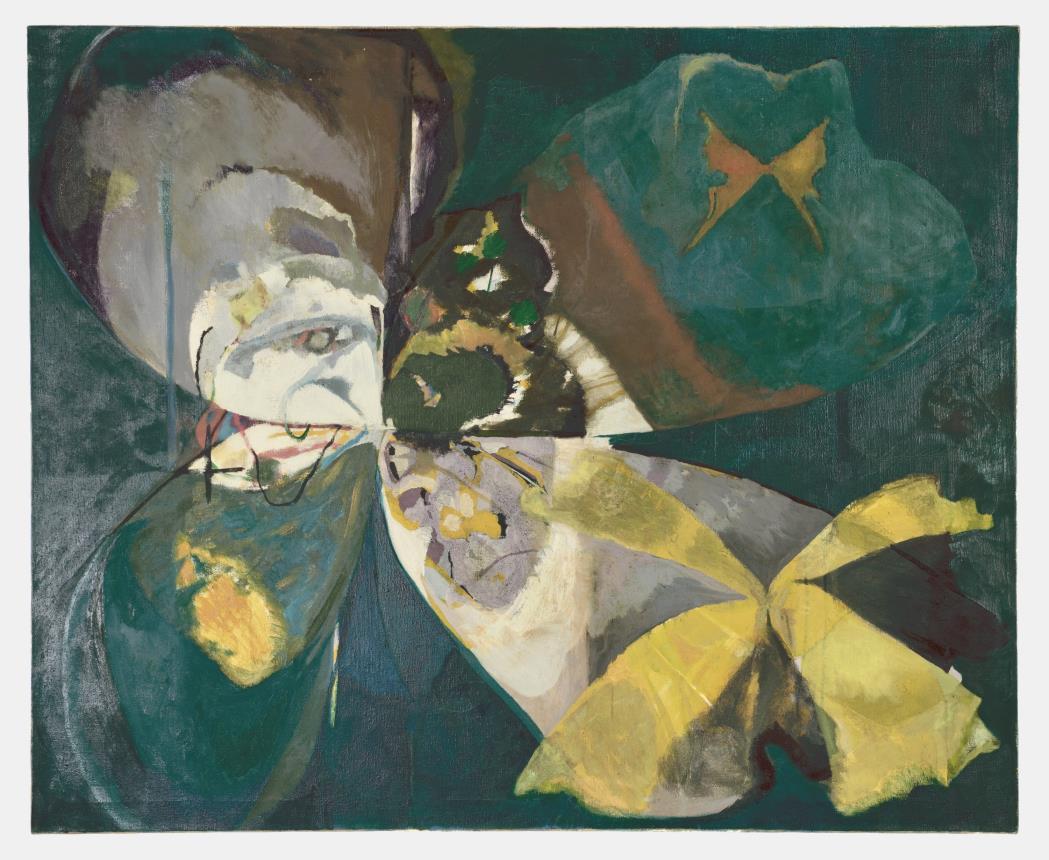
15

16
Mykonos
(c. 1969), Oil on canvas, approx 50 x 24 inches, Private Collection
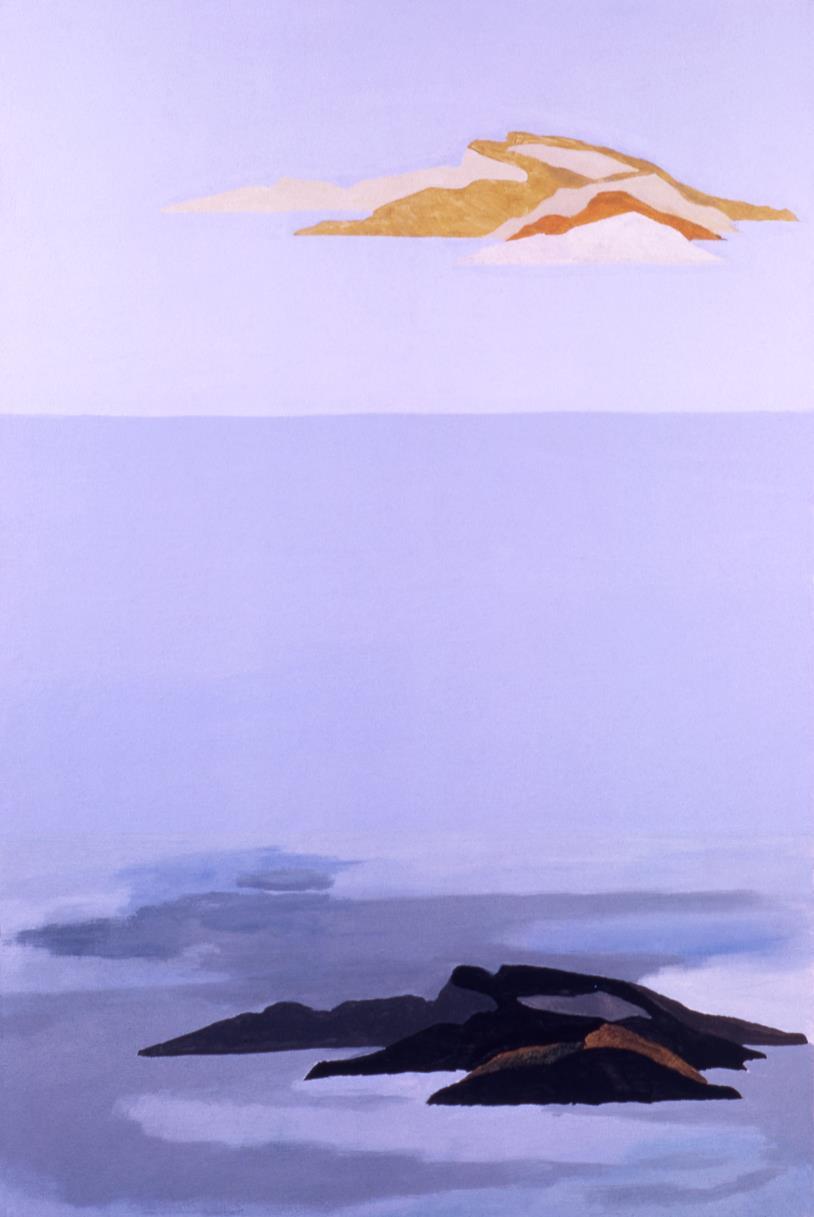
17
Santorini
(c. 1969), Oil on canvas, 30 x 50 inches, Private Collection
18
Galaxies
In the early 1970s, Barr became both interested in cosmic imagery and influenced by the paintings of the Colorfield artists, particularly Helen Frankenthaler, Jules Olitski, and Kenneth Noland. Working on the floor of her studio in Bridgehampton, Barr laid out large, raw canvas onto which she poured acrylic paint from cans, producing fields of single color. She scattered drops of contrasting colors which bled out to evoke distant lights in the night sky. In a similar spirit, her round watercolors, the numbered Star paintings, suggest remote, perhaps magical planets. Meditation provides a parallel, mystical universe into which the viewer can drift, summoning a dreamy state of consciousness. In these early galactic works, Barr ignited a deeply ingrained focus on color that had surrounded her throughout her life.
19
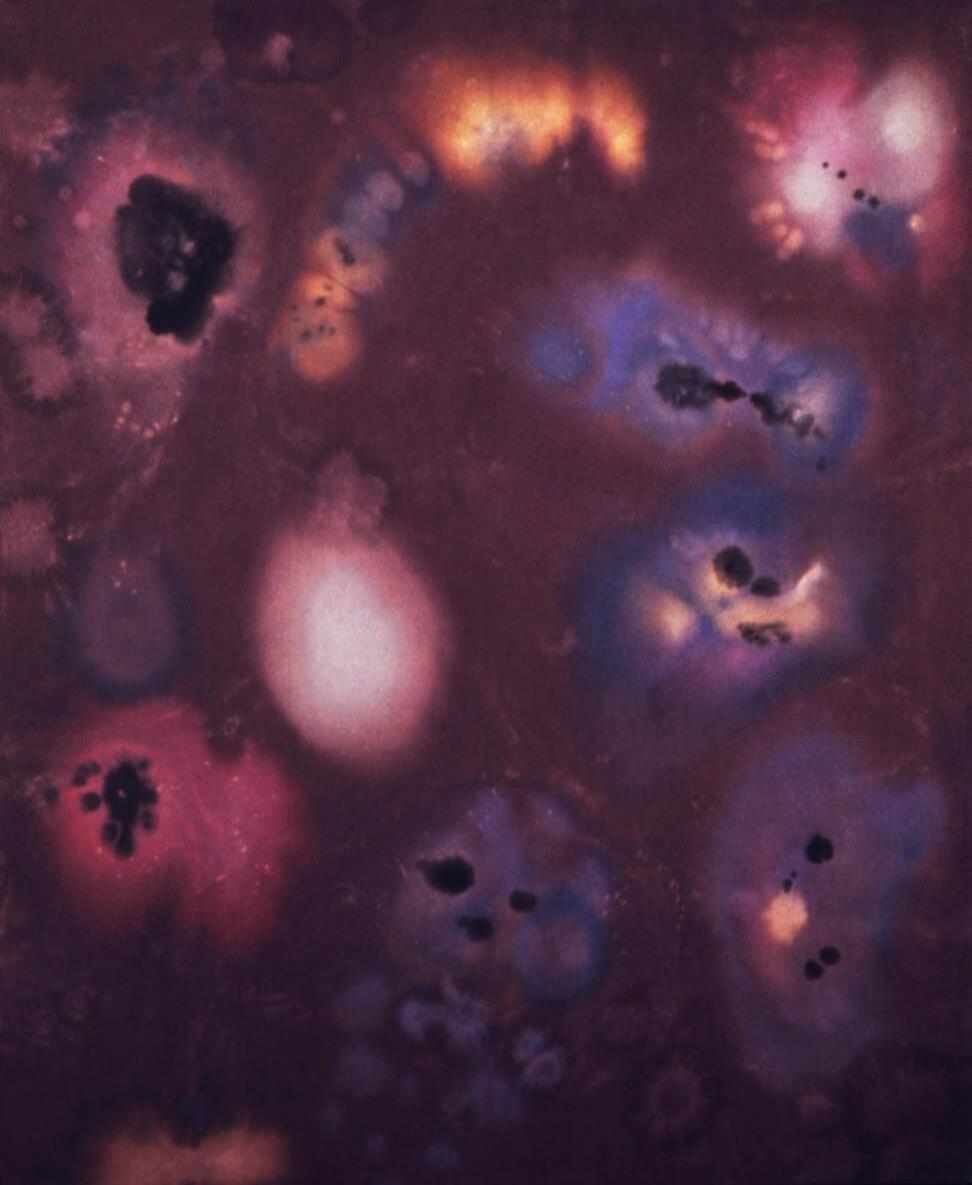
Summer Storm
(c. 1975), Acrylic on canvas, approx. 65 x 48 inches, Collection of Rockefeller University
20

Summer Night
(c. 1975), Acrylic on canvas, approx. 65 x 48 inches, Private Collection
21
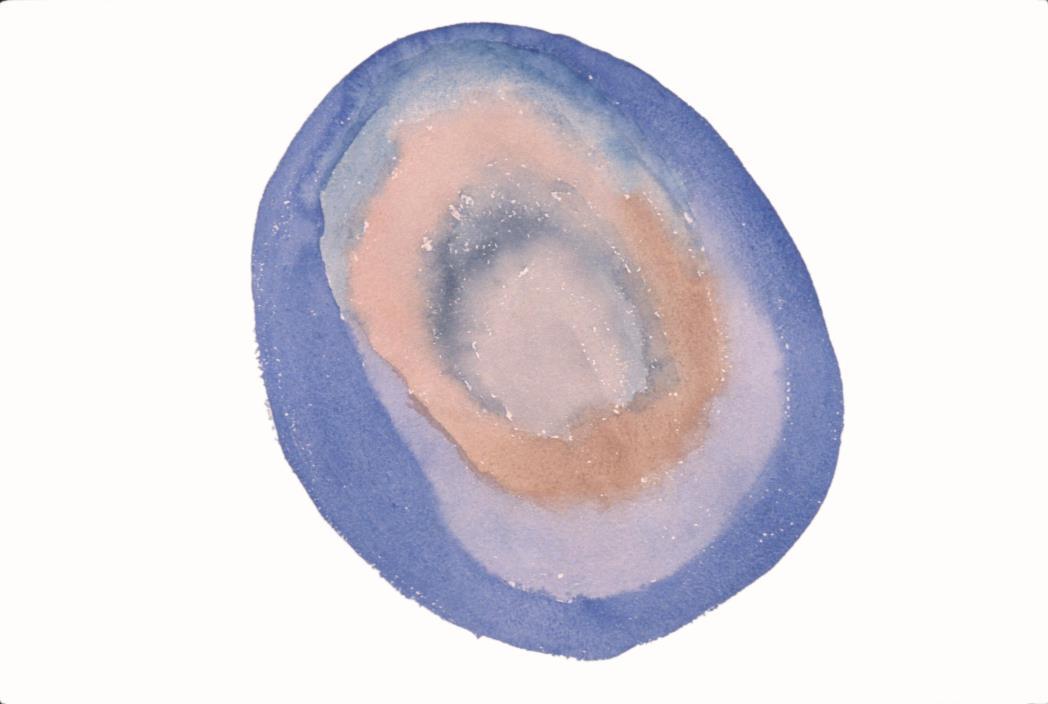
22
Star 5
(c. 1974), Watercolor on paper, 20 x 15 inches, Collection of the Artist
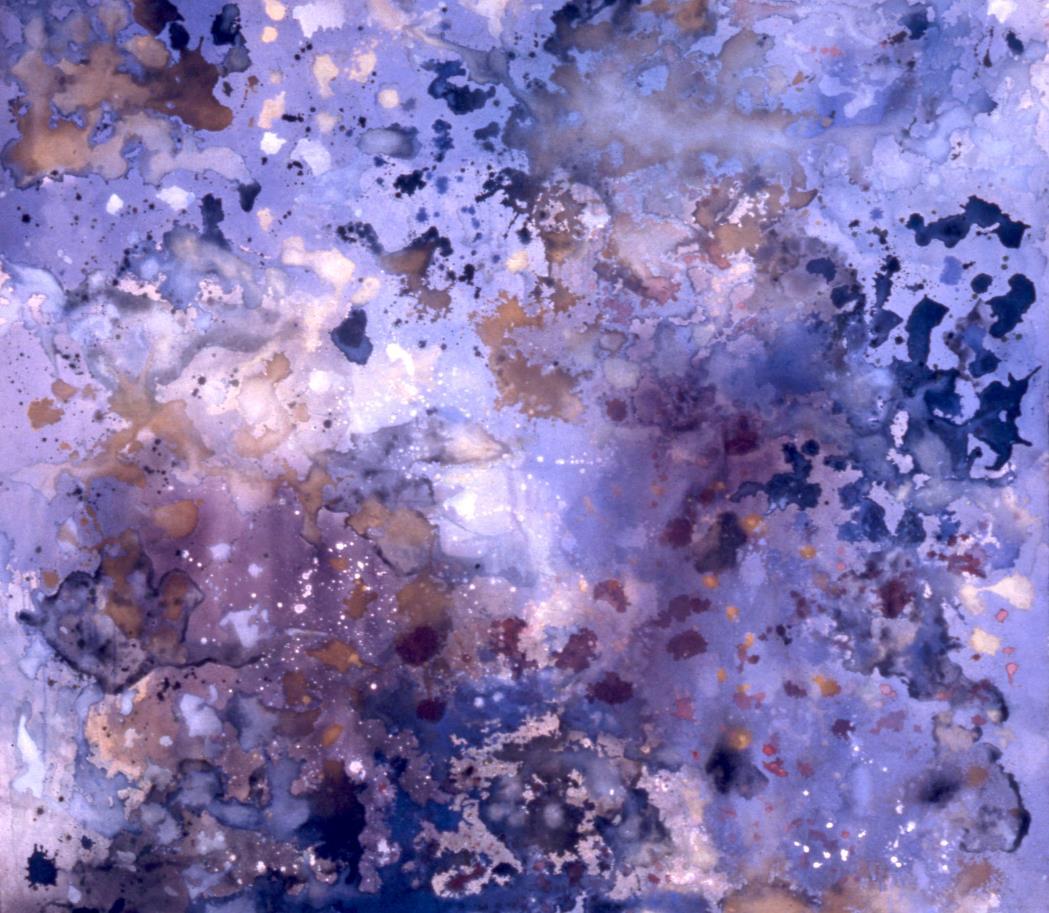
23
Meditation
(c. 1975), Acrylic on canvas, approx 60 x 65 inches, Collection of the Artist

24
Star 4
(c. 1974), Watercolor on paper, 20 x 15 inches, Collection of the Artist

25
Star 3
(c. 1974), Watercolor on paper, 20 x 15 inches, Collection of the Artist

26
Star 2
(c. 1974), Watercolor on paper, 20 x 15 inches, Collection of the Artist
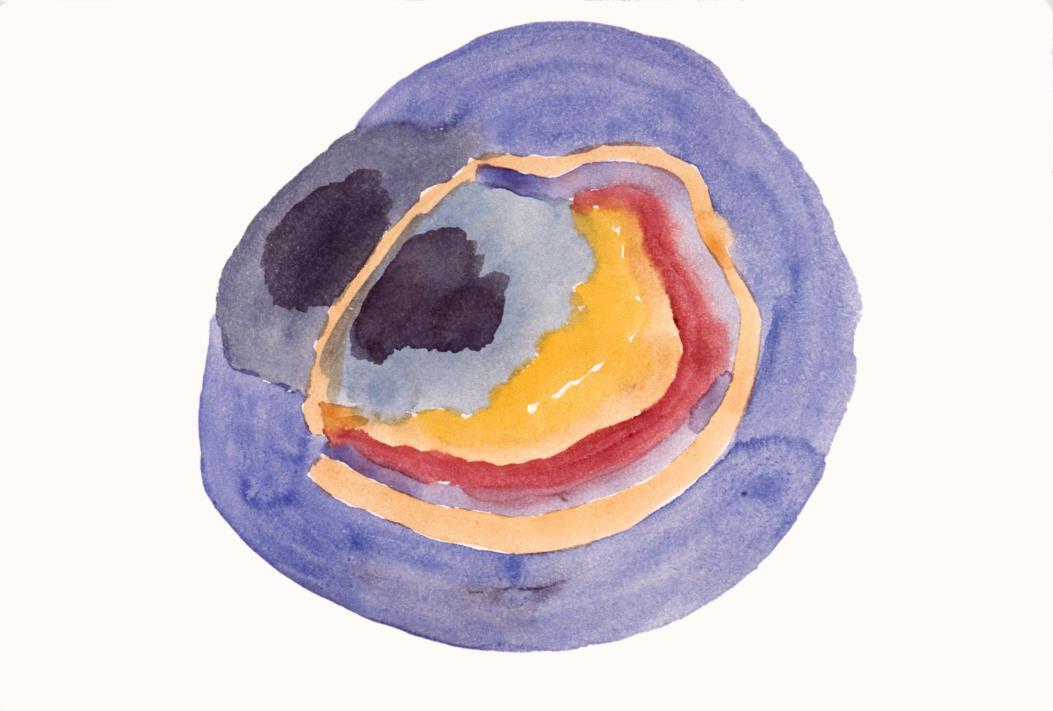
27
Star 1
(c. 1974), Watercolor on paper, 20 x 15 inches, Collection of the Artist
28
Indonesia
Barr spent the late 1970s and early 1980s traveling in Indonesia, living in remote villages in Java and Bali, with little to no contact with the outside world. She was drawn to the dance and music of the islands, and remained enchanted by the color she found. The shadow puppet plays, performed all night long, captivated Barr with a magical world of warriors, princesses, sea monsters, and gods brought to life through silhouette.
Our Friends Merapi and Merbabu, 1984 reflects Barr’s view of the neighboring volcanoes which bordered her studio in central Java. Aspiration, 1985, Reflection, 1985, and Contemplation, 1986, depict the split gate structures of Balinese temple entrances which stand in front of sacred meditation pools. In Sulawesi Ascending, c. 1987, Barr transformed the titular island into wind billowing through the hair of a woman, under which the entire archipelago stretches across the composition. In these paintings, she translated the fluid movement, vibrant color, and rich spirituality she found in Indonesia.
Alfred Barr was diagnosed with Alzheimer’s when Victoria was in her mid-twenties. She trained herself to live knowing that he could die at any moment; he passed away fifteen years later when she was halfway around the world, in Bali on an ethnomusicology tour in 1981. When preparing to leave for New York upon hearing of her father’s death, Barr focused on the sacred mountain Agung which remained nearly permanently shrouded in clouds. Mount Agung was a touchpoint for the Balinese to remain in contact with the gods. Moving along the northeast coastline, Barr turned to say goodbye to the islands, and found that she was lucky – the clouds over Mount Agung had lifted that day, an apt visual end of her father’s long sustained illness and suffering.
29
Sulawesi Water Song (1982)
Oil on canvas, 40 x 50 inches
Collection of Joanna Romer
30

31
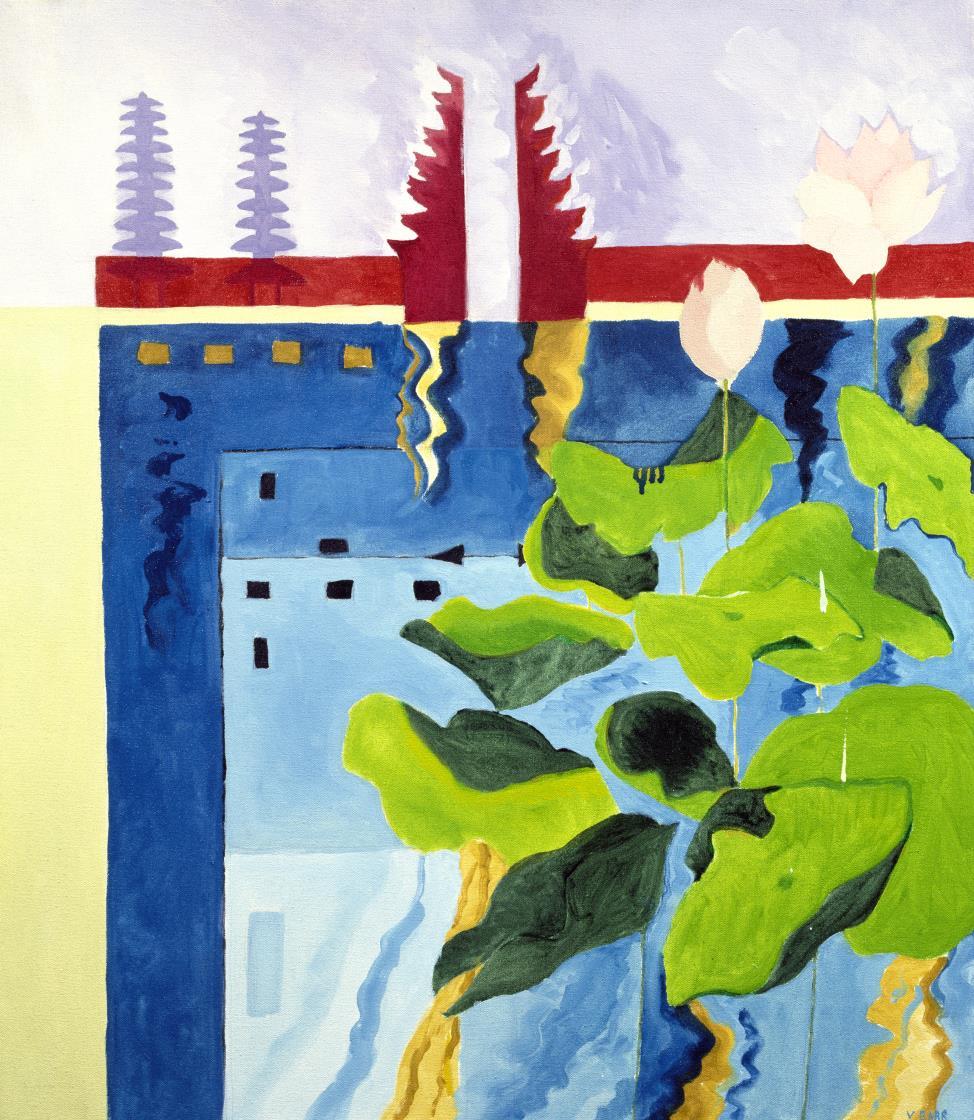
Aspiration, (1985), Mixed media on canvas, 32 x 28 inches, Collection of the Artist
32
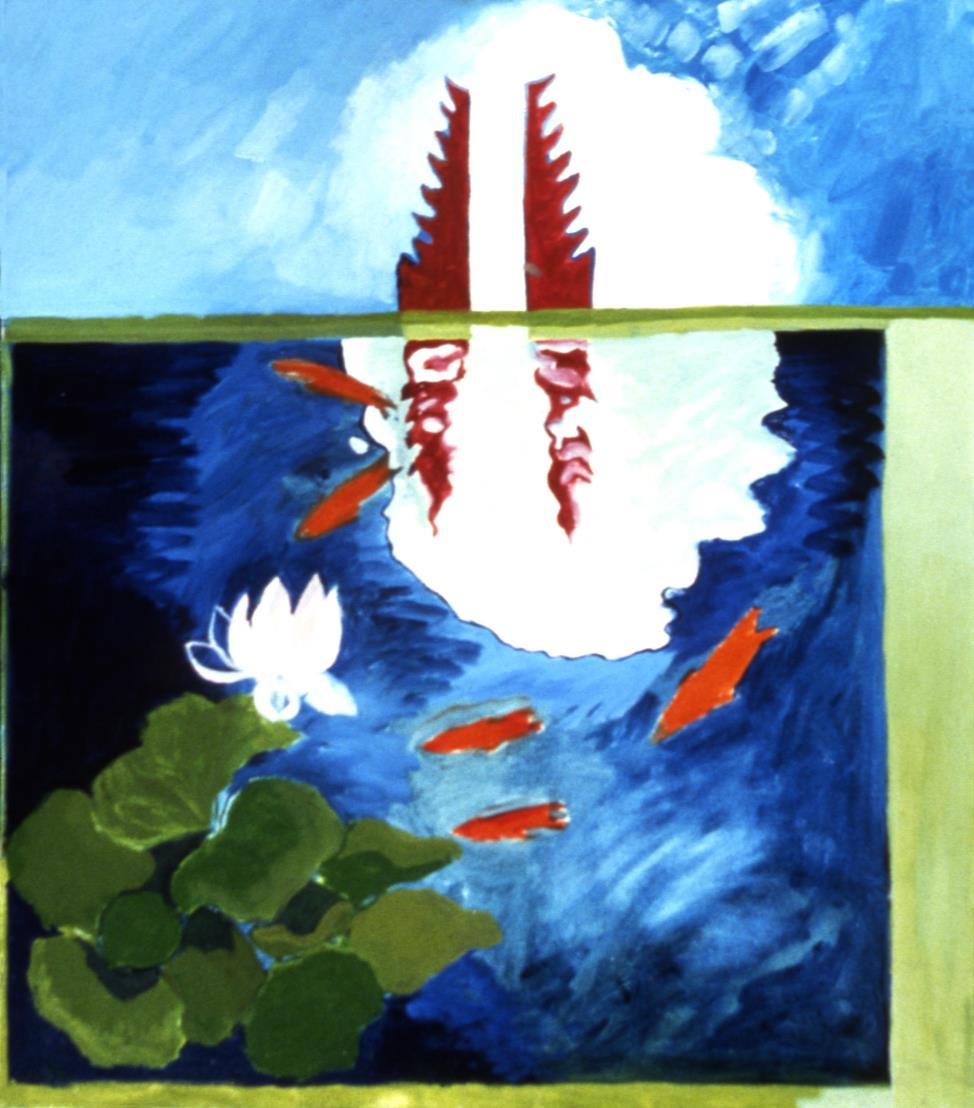
Reflection
(1985), Mixed media on canvas, 32 x 28 inches, Collection of the Artist
33
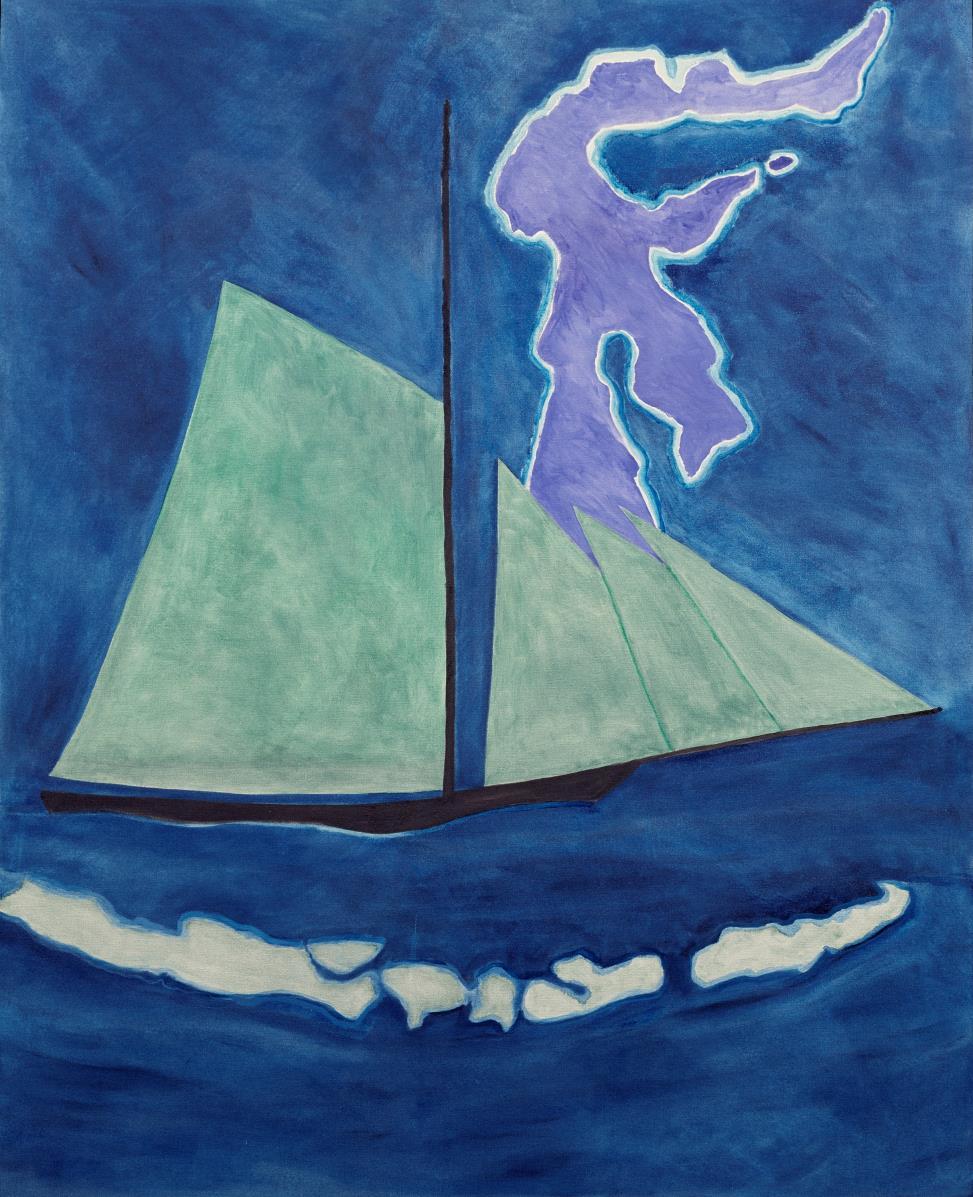
34
Sulawesi Ascending
(c. 1987), Acrylic on canvas, 40 x 50 inches, Private Collection
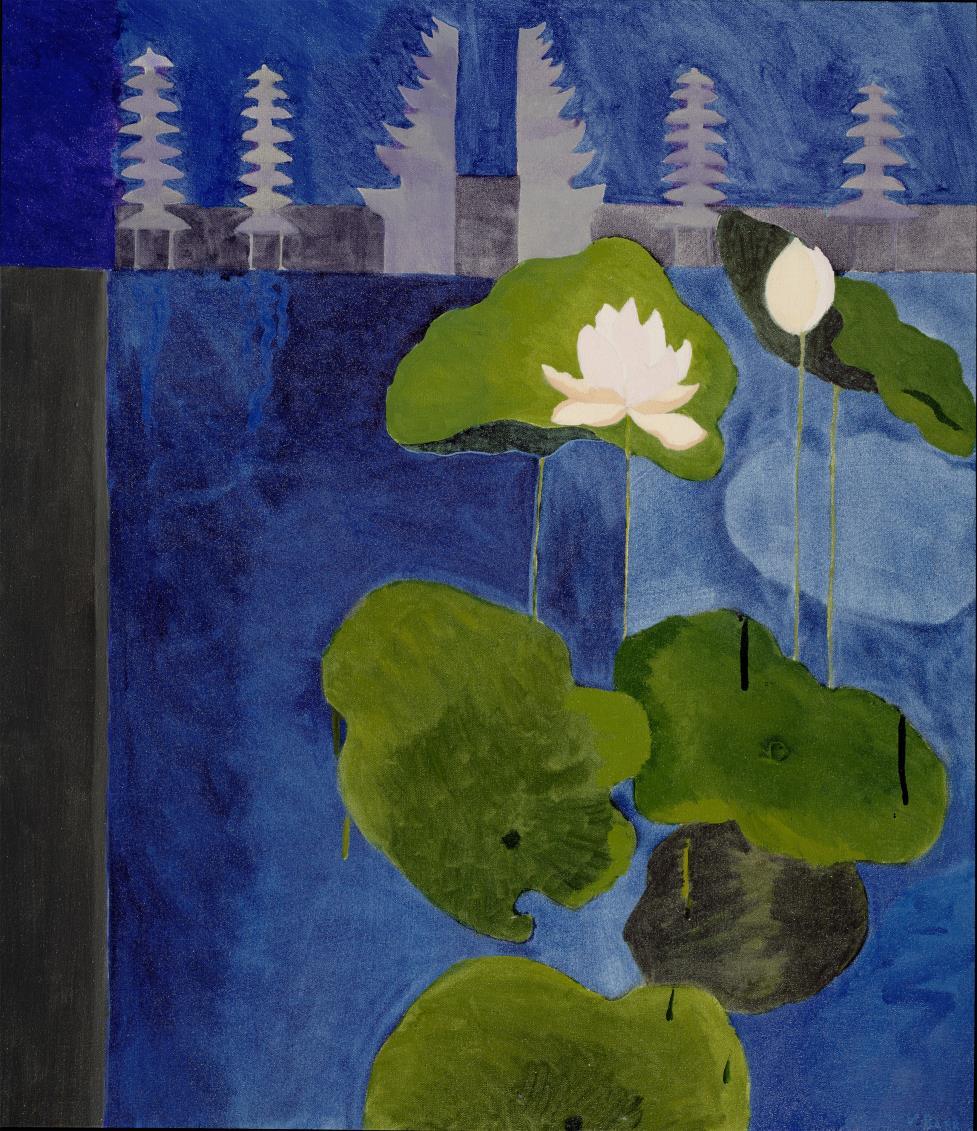
Contemplation
35
(1986), Mixed media on canvas, 32 x 28 inches, Collection of the Artist
Off Sumatra (1984)
Oil on canvas
48 x 65 inches
The Collection of Parrish Art Museum
36

37

Afternoon Studio
38
(1984), Oil on canvas, 68 x 69 inches, Collection of the Artist
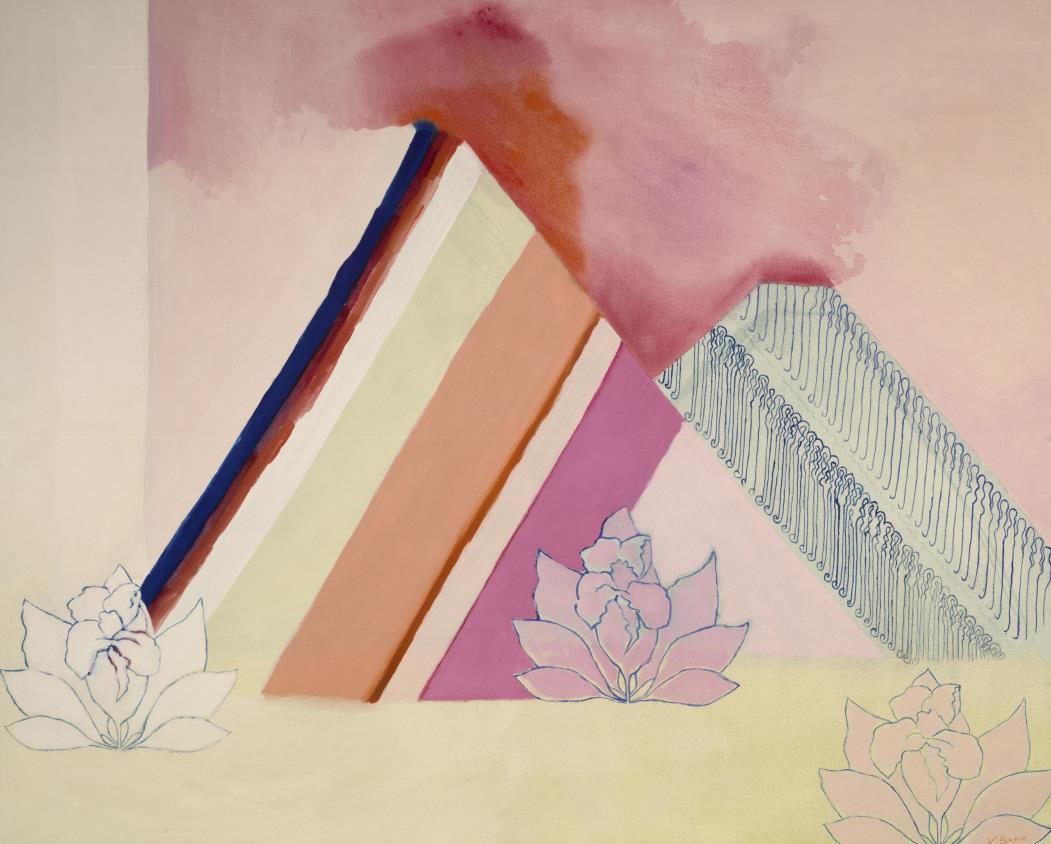
39
Our Friends Mount Merapi and Merbabu (1984), Acrylic on canvas, 40 x 50 inches, Collection of the Artist
40
Demons
In the mid to late 1970s, Barr experimented with the process of automatic drawing and painting, approaching blank canvas and paper with no plan or image in mind. She produced her Demon drawings “from the inside out” firmly pressing down her crayon in an agitated process until gradually arriving at facial constructions. Barr unleashed her subconscious through uninhibited spontaneity, in contrast to her early cosmic paintings from the 1960s, which required a controlled and measured hand. Summoning, 1979 and The Quick, 1979 exemplify Barr’s depictions of night demons from the traditions of Balinese Animism. One must remain alert to evil spirits when walking the island at night, as water was believed to be the source of evil spiritual forces, and mountains the resting place of the good, typified by Mount Agung. In her demon paintings of the late 1970s, Barr filtered her interpretation of these malevolent creatures through the darkened landscape of the rice fields of Bali and subconsciously expressed her anxiety over her father’s long, impending death.
41

Summoning
(1979), Oil on canvas, 40 x 50 inches, Collection of the Artist
42

43
The Quick
(1979), Oil on canvas, 40 x 50 inches, Collection of Serge Mosovich

44
Demon Drawing 1
(1974), Crayon on paper, 23 x 29 inches, Collection of Elsa Williams
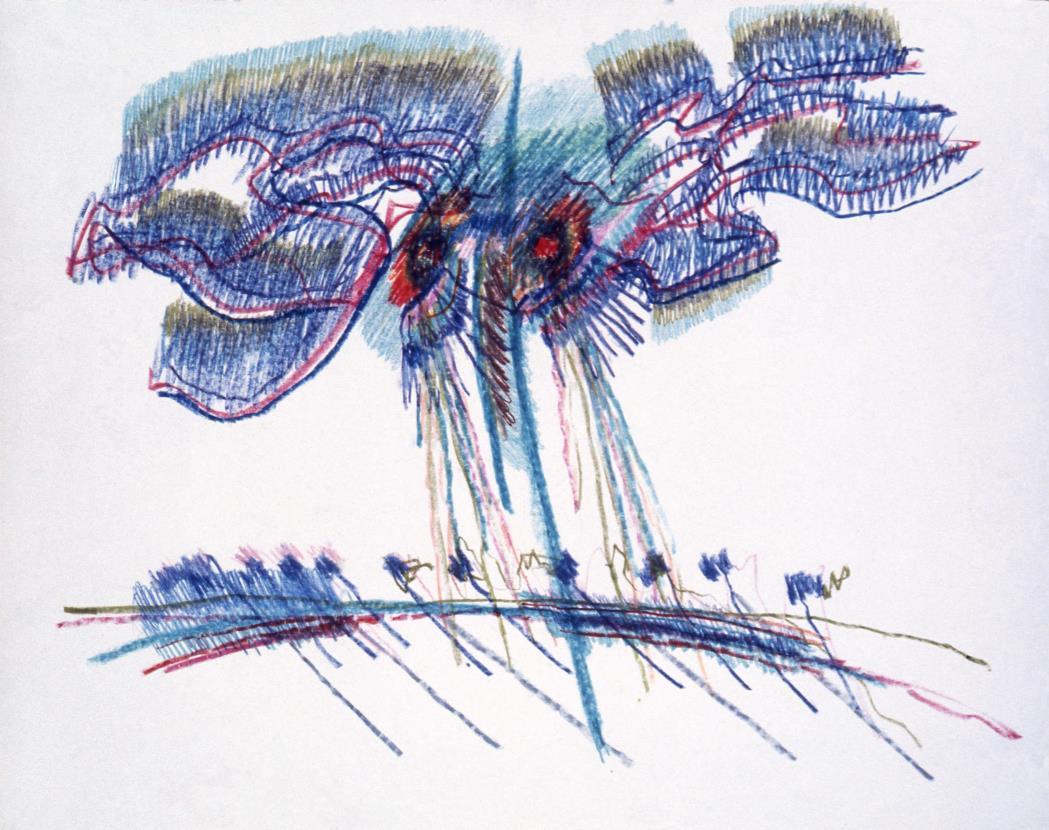
45
Demon Drawing 2
(1974), Crayon on paper, 23 x 29 inches, Collection of the Artist
46
Death
At times Barr turned to painting as a means of direct emotional processing, expression, and closure. She often painted her reaction to death, both of individuals in her life and of those in the public eye. Barr painted What is the Color of Death, 1979 in the days that followed the loss of her friend, Helen Baldwin The artist dropped masked figures across a composition highly saturated in yellow – for Barr, the color of death – under the graffitied words of the painting’s title. The masks recall the stories of the afterlife evoked by the shadow puppets Barr had seen in Indonesia.
A few weeks after the death of her father, Barr produced a seven-foot posthumous portrait of him in a single day, A. H. B. the Artist’s Father, 1981 a painting rich with the iconography of his life. He appears in his famous black overcoat, which he had bought to withstand the Russian winter during his voyage of 1927 and which he wore for over five decades as an avid birdwatcher in central park. A Scarlet Ibis emerges from his head, its wingspan touching the outer edges of the canvas, symbolizing the release of her father’s spirit and his passion for art.
Painted the following year, Departure, 1982 reflects Barr’s retrospective understanding of her father’s death through the imagery of her travels in Bali where she learned of his passing. The ubiquitous Balinese palm trees frame the sailboat which carries his spirit into the sky. Just as the clouds lifted above Mount Agung, the soul of Alfred Barr was released through the clear, serene vision, in stark contrast to the dark thunderous imagery of AHB the Artist’s Father painted the previous year during the grief-filled weeks following his death.
Barr painted Double Portrait of My Mother as the Angel of Death, 1988 a year after her mother’s passing. Her mother’s body, shrouded in brown and winged as the angel of death, rockets across the top half of the composition over the “Meeting of the Waters” in Manaus, Brazil. The two giant tributaries run parallel to one another, ultimately forming the Amazon River. The saturated yellow and blue of the two rivers do not intertwine for several miles because of their differing mineral compositions, producing a rare and sharp visual contrast. Double Portrait, Barr’s complicated farewell to her mother, uses this natural phenomenon to represent their troubled relationship amplified by the dark angel’s skull reflected in the colorful riotous rapids.
The Assassination of Chico Mendes, 1991 presents Barr’s response to the 1988 murder of the activist on the order of a logger, whose plans for deforestation Mendes had successfully thwarted. The trees, striated to reflect rubber harvesting techniques, lift the composition upward toward the sky, creating an opening through which his soul departs. Barr emphasized the violence of his murder in front of his own home through the saturated red blood which contrasts his blue figure. She used the snake as a dual-symbol: one of fertility, presenting Mendes’ hopeful work to preserve and grow the Amazon rainforest, and the other of evil, highlighting the injustice of his assassination.
47
AHB The Artist's Father (1981)
Oil on canvas
76 x 69 inches
Collection of the Artist
48

49
Departure (c. 1982)
Oil on canvas
28 x 32 inches
Collection of the Artist
50

51
Double Portrait of My Mother as the Angel of Death
(1988)
Oil on canvas
65 x 53 inches
Collection of the Artist
52

53
Assassination of Chico Mendes (1991)
Oil on canvas
65 x 48 inches
Collection of the Artist
54

55
What is the Color of Death (1979)
Oil on canvas
67 x 75 inches
Collection of the Artist
56
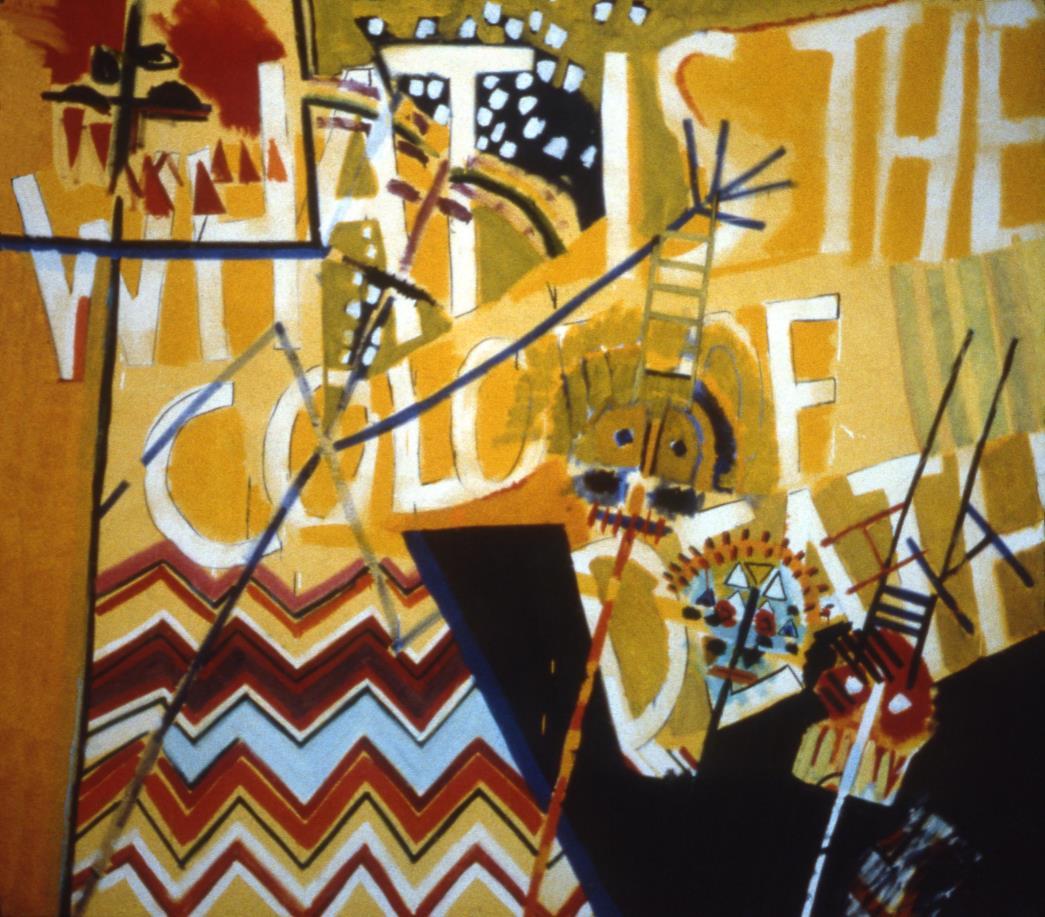
57
58
Amazon
Barr lived and worked in various regions of Brazil and Argentina in the late 1980s and 90s. Many of her paintings from the 1990s express the spirit and imagery of her experiences throughout these travels. She produced Amazon Lilies, 1985 while still in New York, before her first ever trip to the region. The painting presents her imagined prediction of the color and form she hoped she would find in the Amazon. This invented version is surprisingly similar to the paintings she would ultimately create after her arrival; The Dream, 1997 presents the reflection of sunset in the water, an eerie mirror of Barr’s prediction in Amazon Lilies Samba Do Amazonas, c. 1991 and Chorinho do Amazonas, 1991 evoke the spirit of the Amazonian waters and refer to the local traditions of inventing musical poems, linking sonic rhythms with the twists and turns of the landscape.
Rubies and Reflections, 1992 presents the artist’s unique interpretation of the landscape surrounding the Amazon River. At the rainy season’s end, the reflections on the water’s surface are startlingly clear as if a mirror were opening the river to an alternate world. She began Rubies in a horizontal format, building a dual image of foliage on the surface of the water. She then flipped the painting ninety degrees, and superimposed flowers of warm saturated color in contrast to the cool blues and greens of the water. The vibrant juxtaposition produces a dynamic interplay of vision, movement, and fantasy.
59
Amazon Lilies (1985)
Mixed media on canvas
28 x 32 inches
Collection of the Artist
60

61
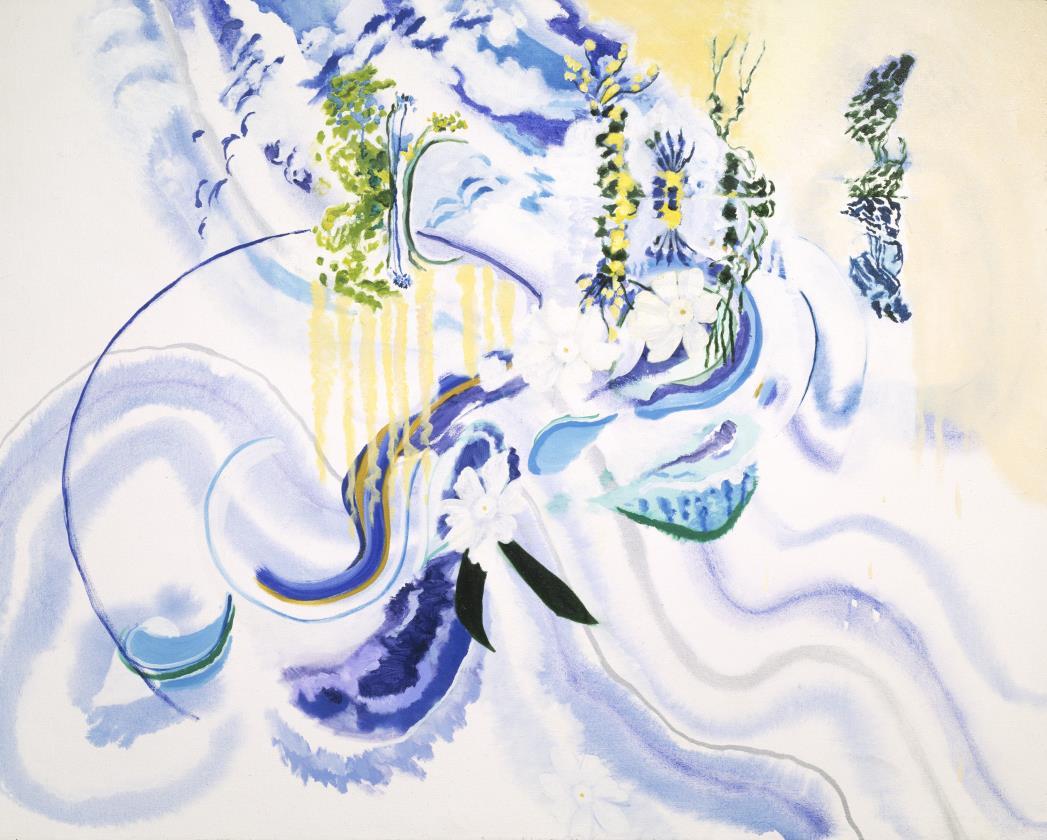
62
Chorinho do Amazonas
(1991), Acrylic on canvas, 40 x 50 inches, Collection of the Artist

63
Samba Do Amazonas (c. 1991), Acrylic on canvas, 40 x 50 inches, Collection of Elsa Williams
Slash & Burn (1992)
Oil on canvas
78 x 40 inches
Collection of the Artist
64
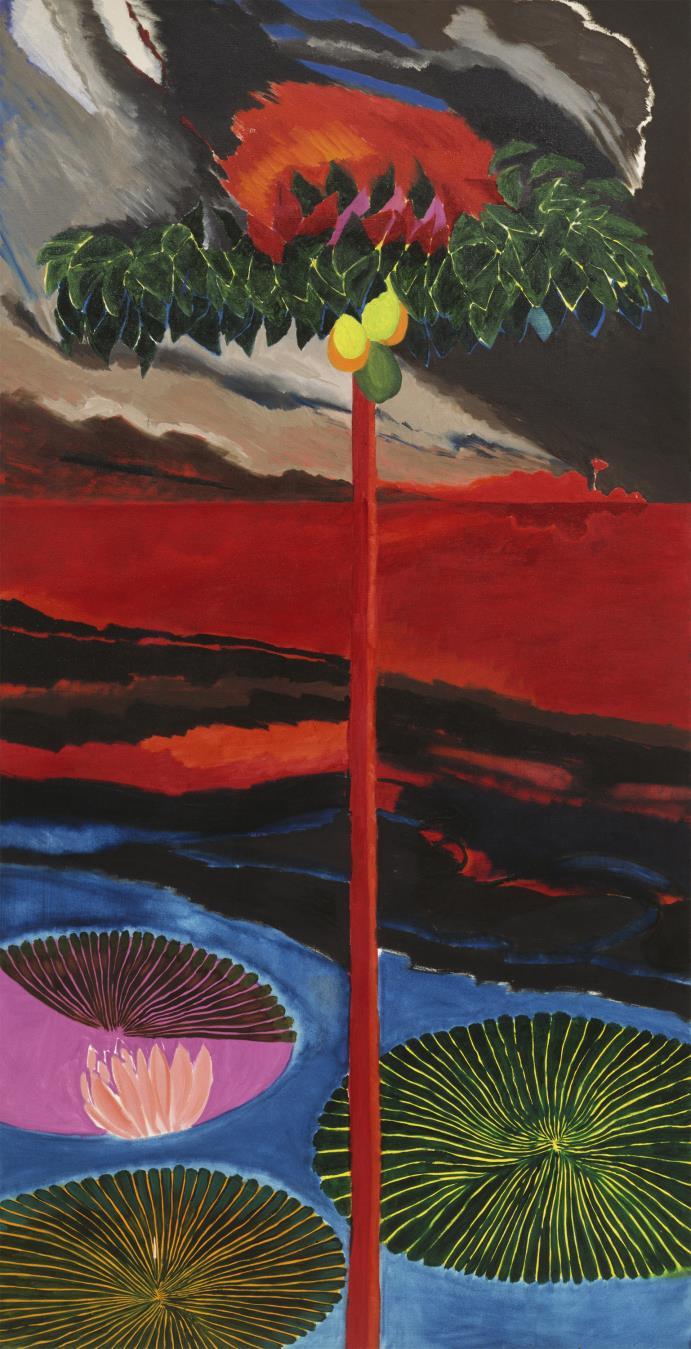
65

66
Jewel of the Amazon
(1990), Mixed media on canvas, 16 x 16 inches, Collection of Brest Museum
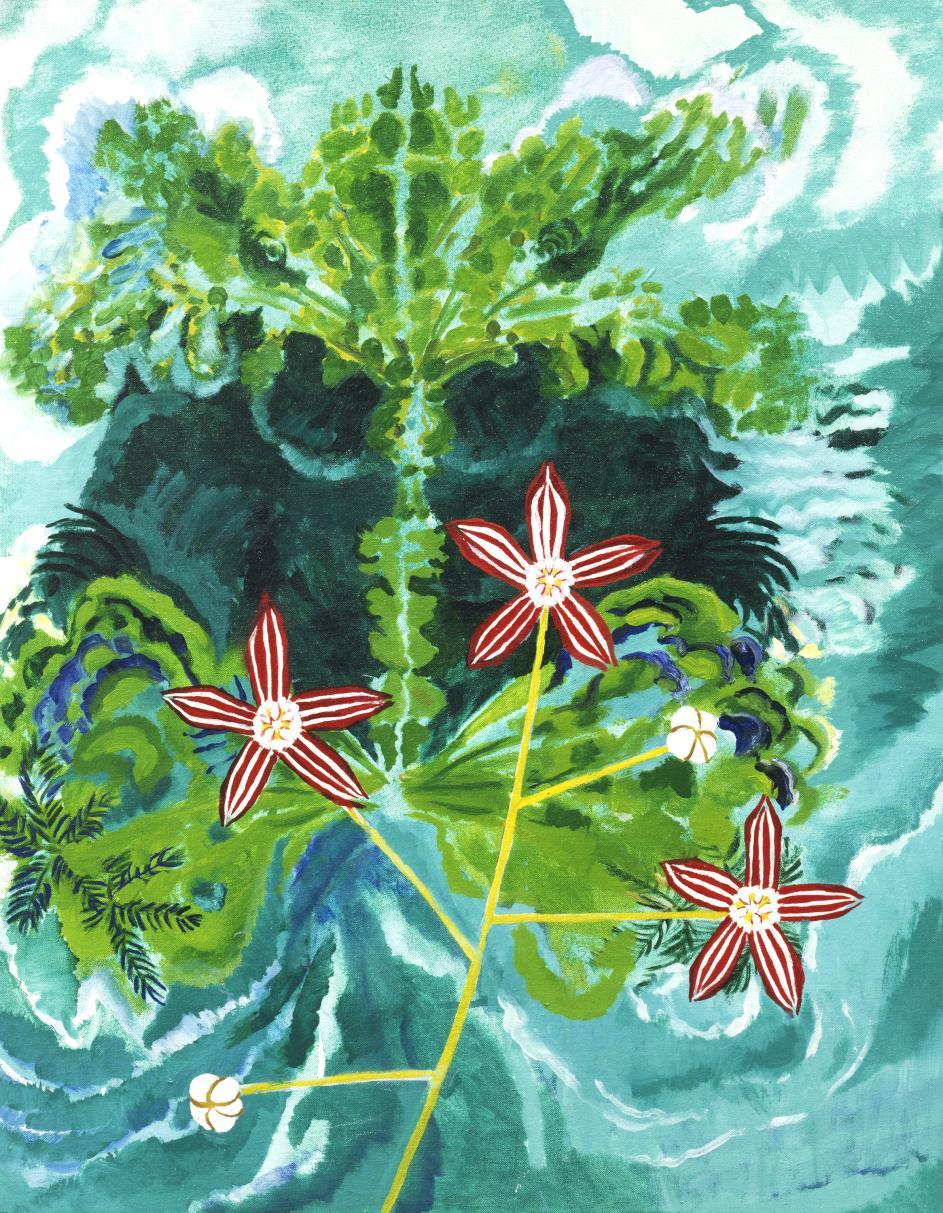
67
Rubies and Reflections
(1992), Mixed media on canvas, 28 x 22 inches, Collection of Andrew Barr

68
Expulsion
(1993), Acrylic on canvas, 65 x 40 inches, Collection of the Artist

The Dream
(1997), Oil on canvas, 28 x 32 inches, Collection of the Artist
69
70
Natural World
Throughout her career, Barr has consistently set her paintings in the natural world either physically, symbolically, or spiritually. During her travels in the 1980s, Barr had become interested in Candomblé, the African religion practiced in Brazil. Bolt, 1995, Xango Tree, c. 1995, and Xango Forest, 1995, are centered on Xango, the dominant central Candomblé god. In Bolt, Xango is depicted as a powerful jaguar, manifested in the midst of a thunderstorm, heightening the overwhelming strength of the figure. Xango reappears with the head of a jaguar at the top of Xango Tree and Xango Forest, flanked by thunderbolts that interrupt dark, mysterious environments. Butterfly Dance, c. 1990, an abstract depiction of the movements of butterflies, encapsulates a structured yet lyrical engagement with movement and synthesizes the various influences and approaches to painting from the eras of Barr’s career, calling upon the free form and composition of her galactic paintings, and the vibrant color palette of her Amazon images.
71
Butterfly Dance (c. 1990)
Acrylic on canvas
50 x 40 inches
Collection of the Artist
72
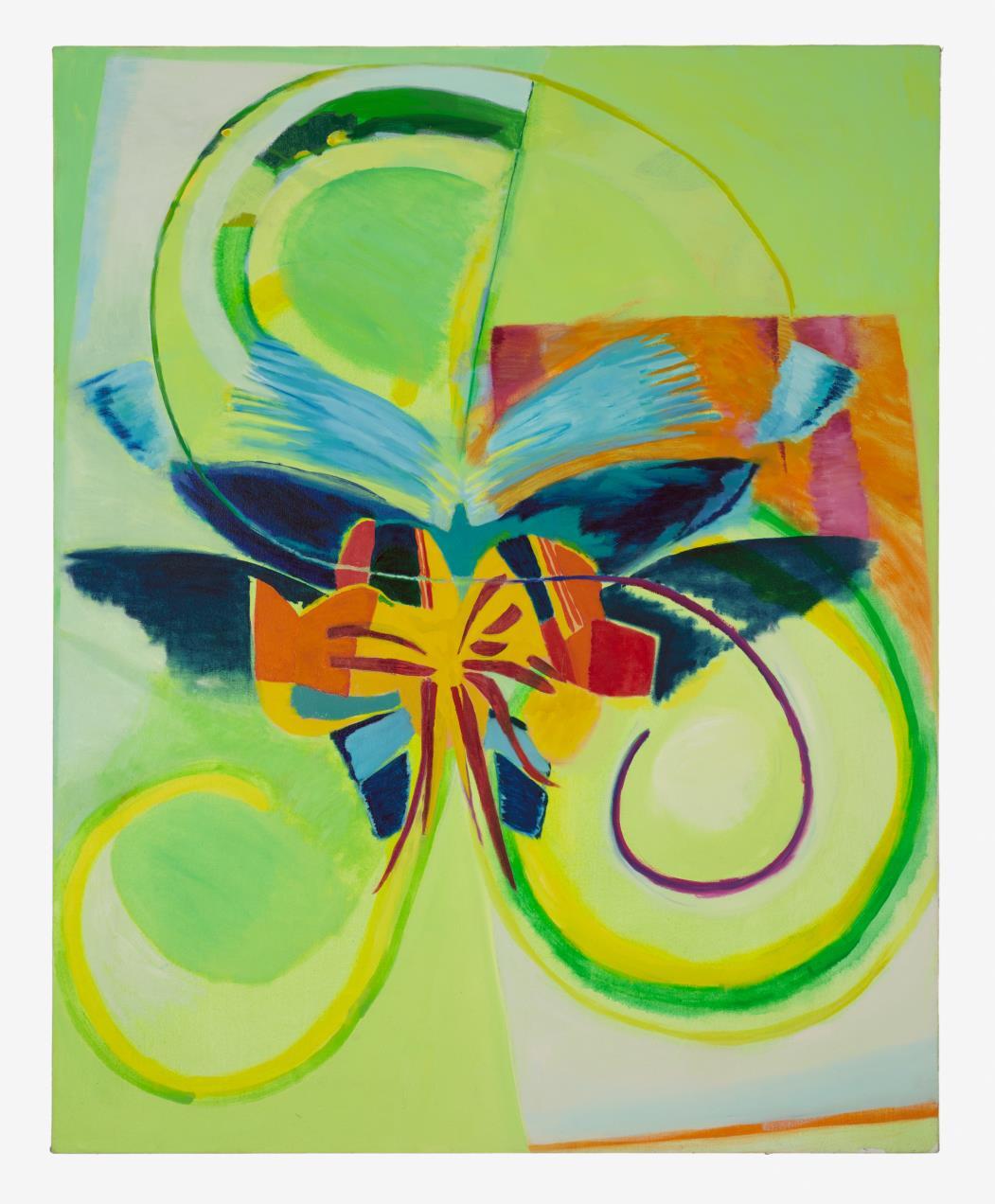
73

Xango Tree (c. 1995)
Mixed media on canvas
56 x 32 inches
Collection of the Artist
74
Xango Forest (1995)
Mixed media on canvas
64 x 30 inches
Collection of the Artist


76
Bolt
(1995), Mixed media on canvas, 54 x 44 inches, Collection of the Artist
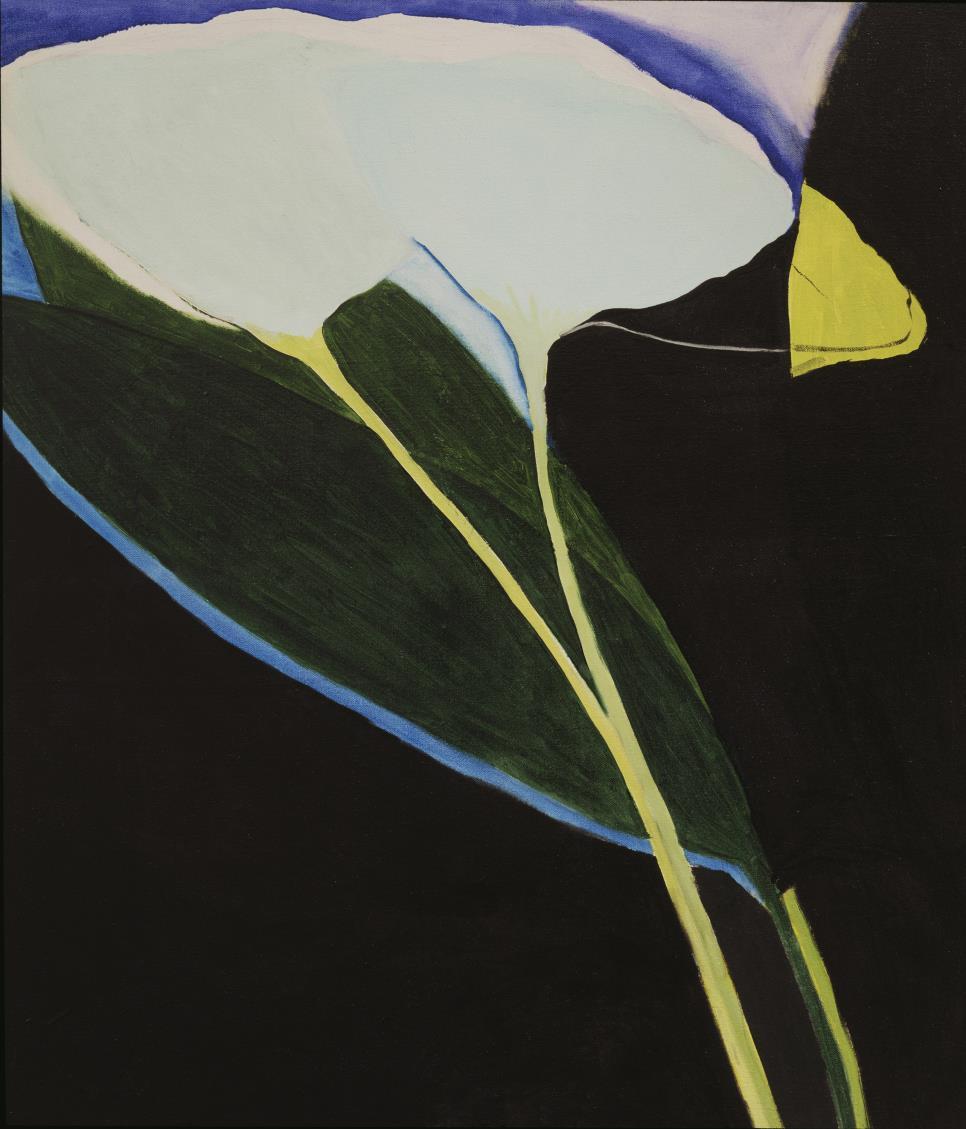
77
Moon Passage
(1995), Oil on canvas, 32 x 28 inches, Collection of the Artist
78
Palm
Even in her most abstract work, Barr never completely abandoned recognizable forms. Some of her largest paintings from the 1990s present structured, intersecting palms against grounds of loose, watery, bright colors. She watered down acrylic paint to achieve an effect akin to watercolor, thereby contrasting the lyrical movement of the background’s nearly transparent colors against the right angles and structured design of interconnected palms. Summer, 1980 and View, 1980 feature in a quartet of similar paintings based on Japanese linked poetry. Her Zigzag series from the late 1990s engages with the Pattern Painting movement and superimposes repeated palm trees onto bands of loose color.
79
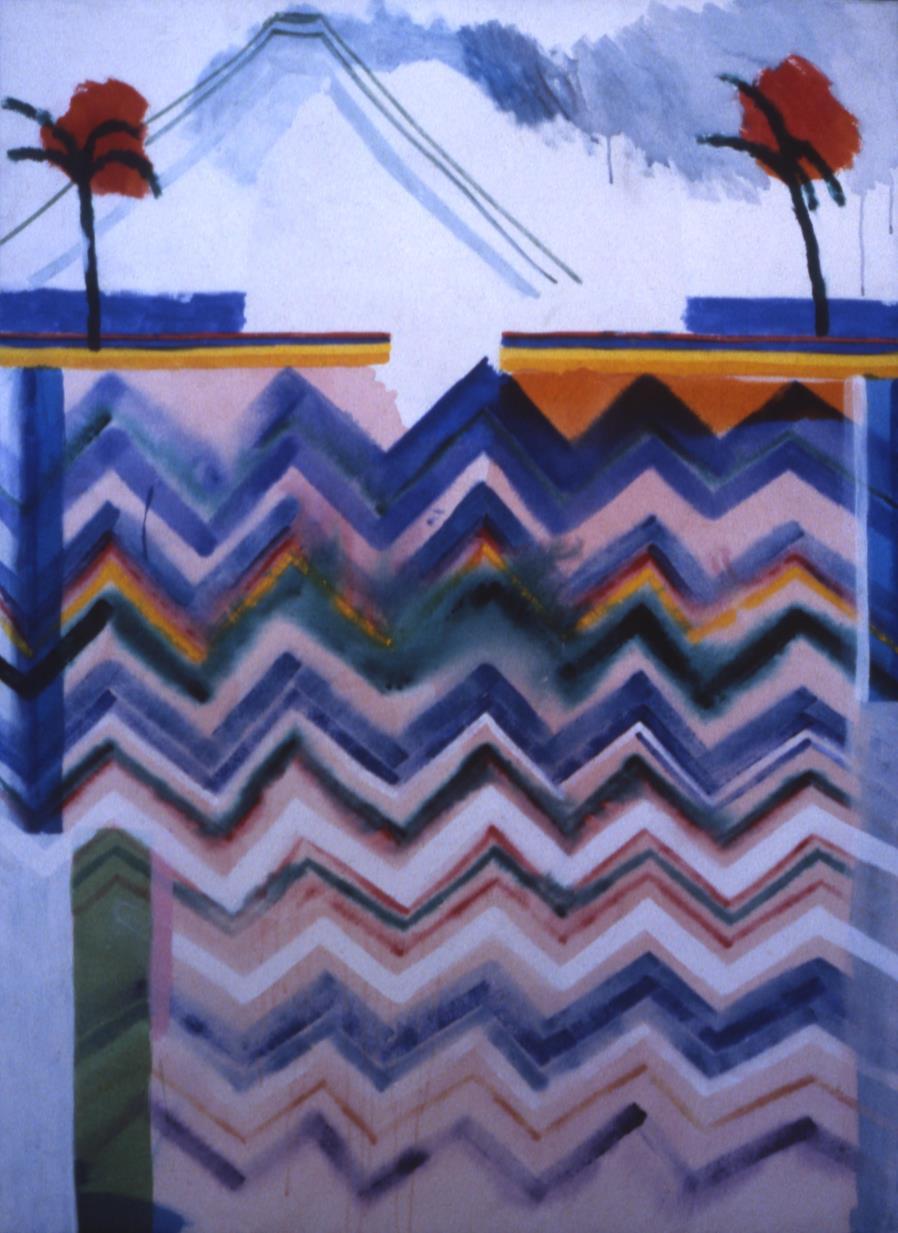
80
Arrival
(1997), Acrylic on canvas, 65 x 48 inches, Collection of Mr. and Mrs. Blumenthal

Summer
81
(1980), Acrylic on canvas, 32 x 28 inches, Collection of the Artist
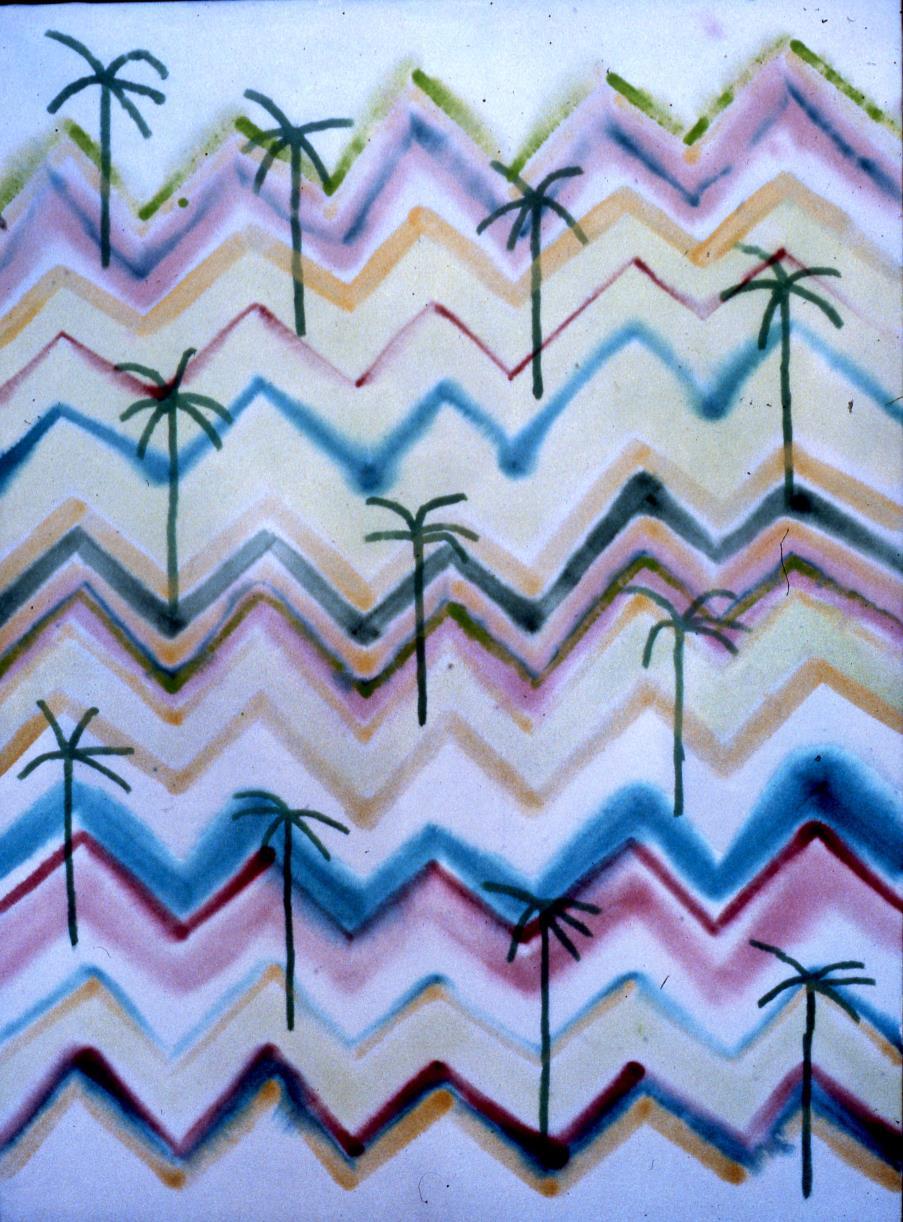
82
Large Palm Zigzag 1
(1997), Acrylic on canvas, 65 x 48 inches, Private Collection
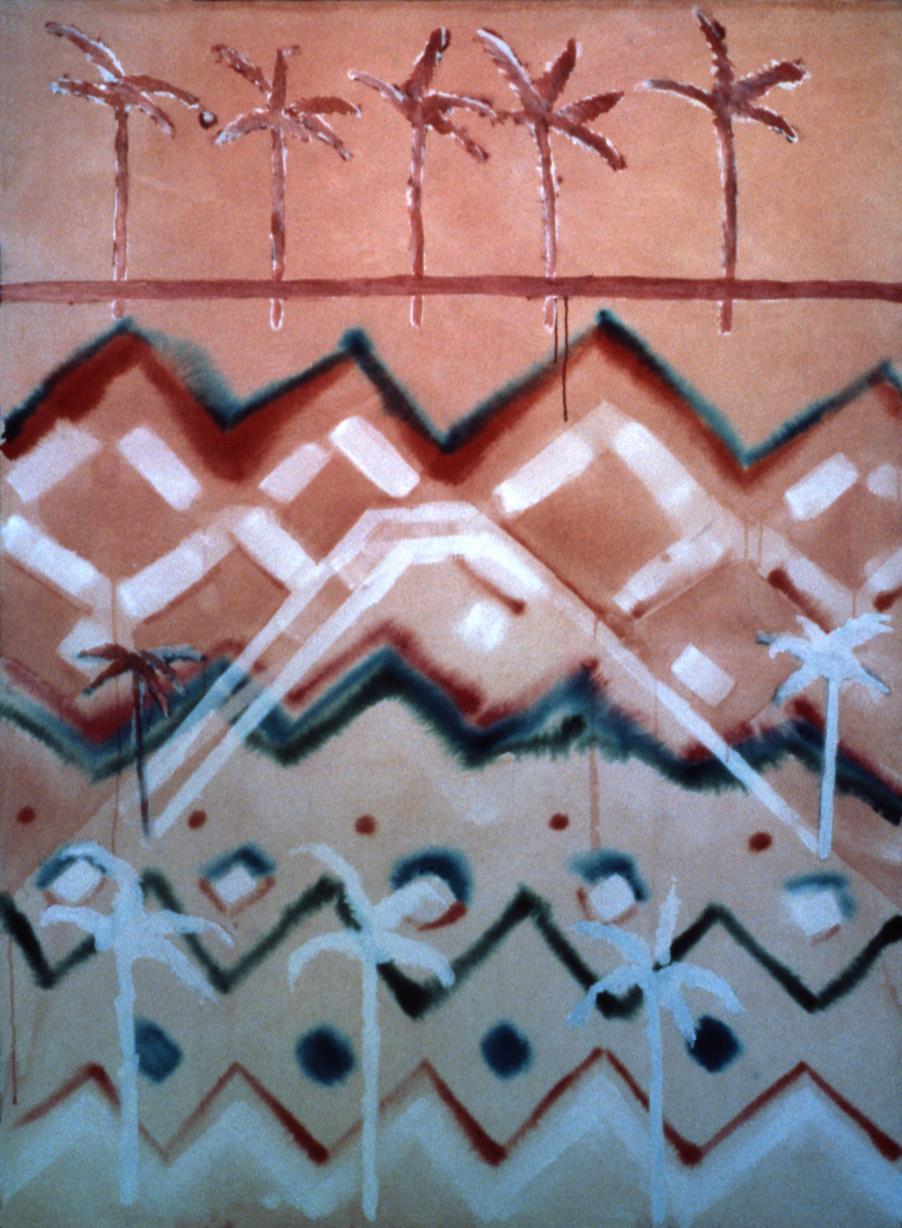
83
Large Palm Zigzag 2 (1997), Acrylic on canvas, 65 x 48 inches, Private Collection

84
Morning
(1997), Acrylic on canvas, 28 x 32 inches, Collection of the Artist
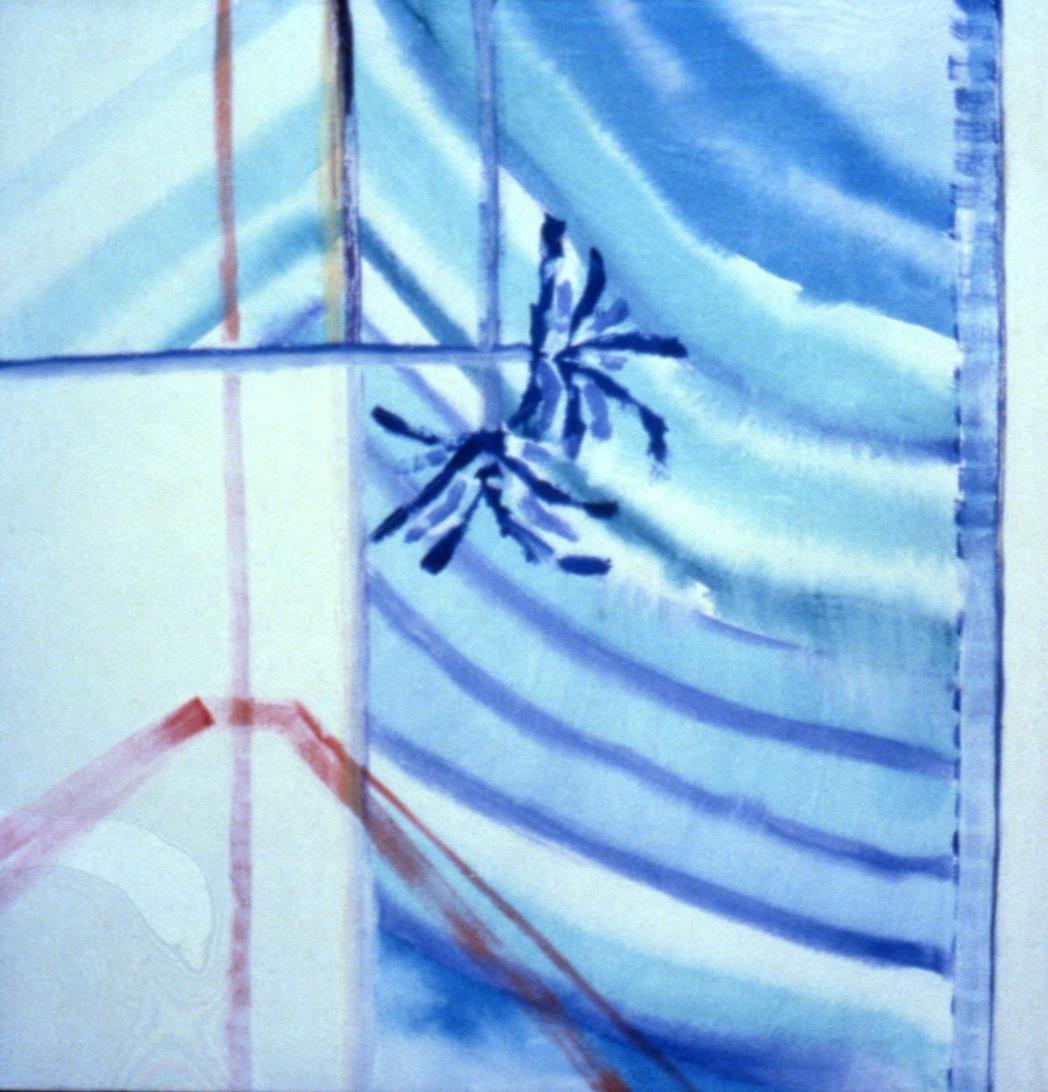
85
View
(1980), Acrylic on canvas, 32 x 28 inches, Collection of the Artist
Plaisir (1980)
Acrylic on canvas
40 x 50 inches
Collection of Richard Ekstract
86
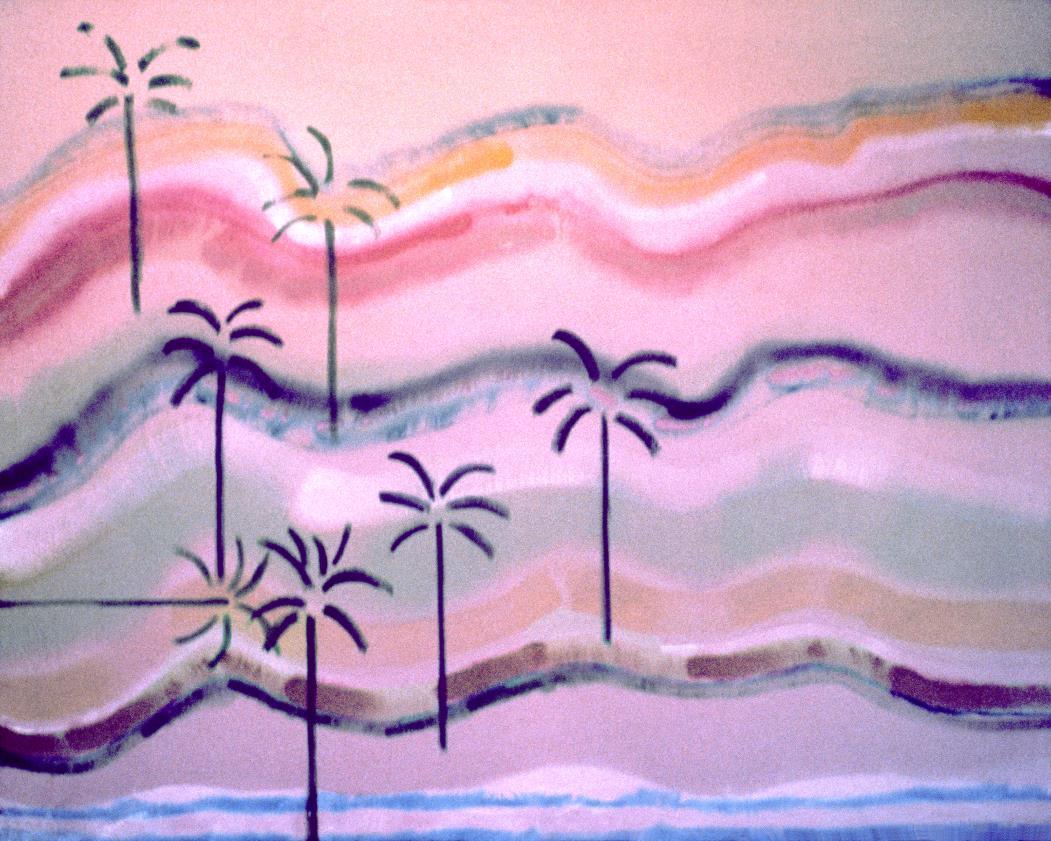
87
88
Barr has spent her career exploring the tensions between abstraction and representation, lyricism and syncopation, and adventure and stillness. Her works beckon the viewer to join in her fascination with distant beauty, mesmerizing and transporting us into alternate worlds, suggesting personal yet universal pain through lenses of nature, abstraction, and spirituality. She provides the viewer with a sense of self-awareness through the contextualization of our own bodies in space and time, grounding us in our own reality through the evocation of another.
89 * * *
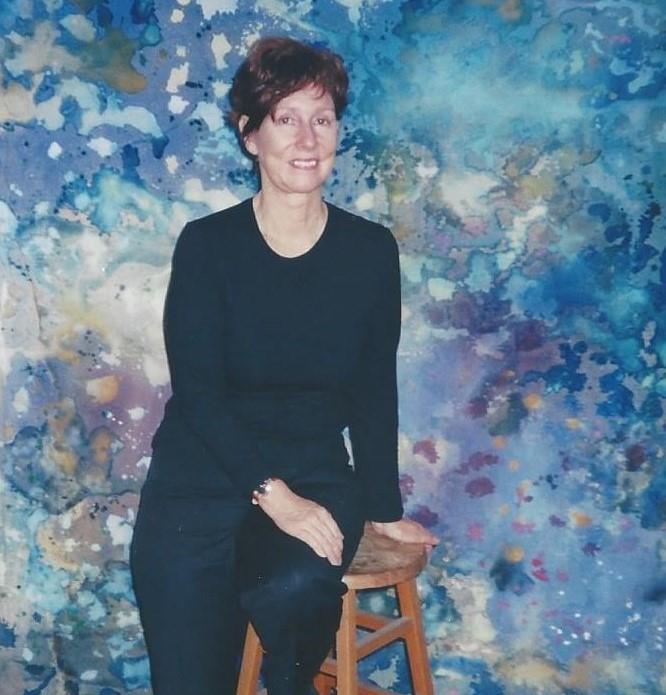
90
Artist Victoria Barr
Selected Solo Exhibitions
Edward R. Gain Gallery, Aspen, Colorado 1962
Gallery Il Bilico, Rome 1965
Patricia Moore Gallery, Aspen, Colorado 1967
Barnard College, New York City 1969
John Bernard Myers Gallery, New York City 1970, 1971
Fischbach Gallery, New York City 1977
Haber Theodore Gallery, New York City 1981, 1982
Galeria Bonino, Rio de Janeiro, Brazil 1987
Museu de Arte de Sao Paolo, Brazil 1992
Museo de Arte Moderno de la Cuidad de Buenos Aires, Argentina 1992
Helander Gallery, Palm Beach, Florida 1994
Alexander Brest Museum, Jacksonville, Florida 1995
Selected Group Exhibitions
Aldrich Museum of Contemporary Art, Ridgefield, Connecticut
Whitney Museum of American Art, New York City
American Federation of Arts, New York City
The Heckscher Museum, Huntington, Long Island
John Bernard Myers Gallery, New York City
Bard College, Annandale-on-Hudson, New York
Fourcade Droll Gallery, New York City
Hamilton Gallery of Contemporary Art, New York City
Smithsonian Institution, Washington, D.C.
Tibetan Tantric Buddhist Center, New York City
Indianapolis Museum of Art, Indiana
Fischbach Gallery, New York City
500 Exposition Gallery, Dallas, Texas
One Penn Plaza, New York City
New York Botanical Garden, New York City
Bergen Museum of Art, Paramus, New Jersey
South Florida Art Center, Miami, Florida
Selected Collections, Museums, Corporations, Institutions
Aldrich museum of Contemporary Art, Ridgefield, Connecticut
Alexander Brest Museum, Jacksonville, Florida
Amstar Corporation, New York City
Art Planning Consultants/Ivan Chermayeff, New York City
Atlantic Ridgefield Corporation, San Diego, California
Barnard College, New York City
Chase Manhattan Bank, New York City
Columbus Gallery of Fine Arts, Ohio
FMC, Chicago, Illinois
Frank Williams & Partners Architects, New York City
Oklahoma Art Center, Tulsa, Oklahoma
Palm Beach Community College, Florida
Parrish Art Museum, Southampton, Long Island, New York
Phoenix Art Museum, Arizona
Port Authority of New York and New Jersey
Smith College Museum of Art, Northampton, Massachusetts
University of Utah Art Museum, Salt Lake City, Utah
Whitney Museum of American Art, New York City
Various private collections
91
Acknowledgements
I am forever grateful to Peter “Rudi” Millard, Dr. Eva Zak, Karen Gutfreund, Abby Robinson, Joe Sinnott, Agga Szcepanski, Sunday Humphries, Dr. Barry Weinberg, Dr. Barbara Hogan, Andrew Barr, Elsa Barr Williams, the late Neil Welliver, Anne Stebinger, Philip Yampolsky, Carol Gracie, Scott Mori, and the crew of the “Cicla Ocilaris”.

92






















































